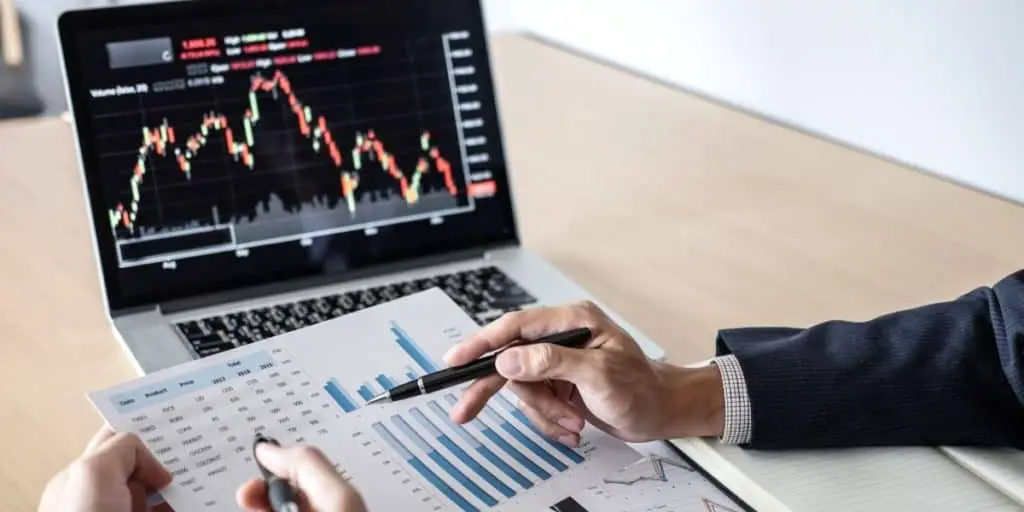Exchange-Traded Funds, or ETFs, are an increasingly popular investment vehicle, as they allow investors to diversify their portfolios easily and follow the trend of the market. They consist of various securities such as – stocks, bonds, and precious metals. However, can a ETF’s holdings change over time?
Index ETF holdings can change when there are changes in the index that they are designed to mimic, and they happen quarterly or annually. Contrarily, actively managed ETFs can change holdings whenever the fund’s management decides to do so. Depending on how actively a fund is managed, its holdings can change daily or after a more extended period.
This article will help you understand what ETFs consist of and how the process of creating and redeeming fund shares works. You will also learn how ETFs are managed and under what circumstances their holdings can change.
IMPORTANT SIDENOTE: I surveyed 1500+ traders to understand how social trading impacted their trading outcomes. The results shocked my belief system! Read my latest article: ‘Exploring Social Trading: Community, Profit, and Collaboration’ for my in-depth findings through the data collected from this survey!
Table of Contents
What Are ETFs Made Of?
You can compare the holdings of an ETF to those of a mutual fund, which can contain stocks, bonds, currencies, or commodities like gold.

The main difference between exchange-traded funds and mutual funds is that ETFs trade on the exchanges throughout each day, while mutual funds can only be bought or sold based on their price at the day’s end.
An ETF is a basket of securities that trades like a single stock on the exchanges.
They can be bought and sold through a brokerage or directly on stock exchanges. As the value of its securities changes throughout the day, so will the price of the ETF.
ETFs are great because they provide flexibility and allow investors to gain exposure to a variety of markets. They can follow the price of an index, a combination of select companies, or a particular industry.
These funds’ variety in holdings can be excellent for investors who want to diversify their portfolios.
The Creation and Redemption Mechanism
Shares of an ETF are created and sold thanks to the creation and redemption process. Authorized participants, which are typically investment banks or market makers, are a crucial element in facilitating this process.
APs are organizations that are allowed to create and redeem shares of an ETF. Let’s take a look at these processes now.
Creation
During creation, authorized participants assemble the underlying securities of the ETF and create a large number of shares. Most ETFs start with 50,000 shares. These securities are then delivered to the ETF sponsors, the firm that came up with the idea for the fund and applied for its authorization.
The ETF sponsor then bundles the shares into the ETF wrapper and delivers them back to the AP. The authorized participant lists the shares on the stock market, where they can be bought and sold by traders.
If the demand for the ETF increases, the authorized participants can create more shares through the same process.
Redemption
The opposite of the creation process is the redemption process.
Redemption is especially useful when the demand for the ETF decreases, as it allows the ETF to be disassembled into single securities. The redemption process leads to an equalization of the market value and net asset value.
When the demand of an ETF drops, the fund returns a portion of its shares to the APs, who then redeem them in exchange for cash.
The creation and redemption mechanism is the process that allows for changes in a particular ETF’s holdings. The ETF managers and the authorized participants work together to facilitate the change by selling the undesired and buying the desired securities that the fund wants to hold.
APs constantly monitor the demand for ETFs to act by adding or subtracting fund shares quickly. The addition or subtraction of shares is done to keep the value per share of the fund as closely aligned with the value of its underlying assets as possible.
This video from ETF Securities by WisdomTree does a great job of explaining the entire creation and redemption process.
Changes in an ETF’s Holdings
Almost every ETF will experience some changes in holdings in its life cycle. Even ETFs created for long-term holding, and passive management may change their holdings after a few years to improve the fund’s quality. For other ETFs, these changes can happen daily.
So, let’s look at some different types of exchange-traded funds and see how their holdings may change over time:
Index ETFs
Most ETFs are index funds, meaning that they hold shares of the companies in a particular index.
Each time the holdings of the index change, the change is replicated in the fund. These changes never happen daily with index ETFs since most indexes change holdings either quarterly or annually.
Let’s use the S&P 500 index as an example.
This index contains the US’s most prominent publicly traded companies based on market capitalization. After earnings reports are released each quarter, some companies leave, while some enter the S&P 500.
The holding of the index ETF will thus change quarterly as well.
Actively Managed ETFs
Actively managed ETFs follow the investment picks of the fund’s manager. While some actively managed ETFs will also have an underlying index, they are not bound to follow what the index is doing strictly.
Instead, these funds have a team of managers and professionals that use research and strategies to beat the market by constantly changing their positions based on what’s happening.
For actively managed ETFs, changes can happen daily, as the managers constantly try to improve the quality of the fund and maximize the returns for the shareholders. These ETFs usually contain hundreds, if not thousands of securities, often changed on the exchanges every day.
Commodity ETFs
Commodity funds track the price changes of commodities like gold, oil, or silver. In other cases, these ETFs can contain the companies that produce commodities. Whatever the case may be, these funds rarely change their holdings.
For example, a commodity ETF may track the prices of agricultural goods, precious metals, or base metals. Since the commodities are constant, there isn’t much chance that these funds can experience.
Currency ETFs
Currency ETFs are an example of exchange-traded funds that never change holdings. These ETFs track the prices of a single currency or a bundle of different currencies and protect investors from a drop in the value of a particular currency.
Choosing an ETF To Invest In
You may want to determine whether you want to invest in a fund that consistently swaps its underlying securities, or a fund that doesn’t, based on your investment goals.
Actively managed funds that change their assets consistently will attempt to beat the market by making more profit for shareholders. These funds are excellent if you want experienced professionals to handle your money on the stock market and make wise decisions based on knowledge and experience.
If you are more in favor of buying and holding assets as they appreciate over a more extended period, passively managed funds that seldomly make asset moves would probably be more aligned with your investment strategy.
Author’s Recommendations: Top Trading and Investment Resources To Consider
Before concluding this article, I wanted to share few trading and investment resources that I have vetted, with the help of 50+ consistently profitable traders, for you. I am confident that you will greatly benefit in your trading journey by considering one or more of these resources.
- Roadmap to Becoming a Consistently Profitable Trader: I surveyed 5000+ traders (and interviewed 50+ profitable traders) to create the best possible step by step trading guide for you. Read my article: ‘7 Proven Steps To Profitable Trading’ to learn about my findings from surveying 5000+ traders, and to learn how these learnings can be leveraged to your advantage.
- Best Broker For Trading Success: I reviewed 15+ brokers and discussed my findings with 50+ consistently profitable traders. Post all that assessment, the best all round broker that our collective minds picked was M1 Finance. If you are looking to open a brokerage account, choose M1 Finance. You just cannot go wrong with it! Click Here To Sign Up for M1 Finance Today!
- Best Trading Courses You Can Take For Free (or at extremely low cost): I reviewed 30+ trading courses to recommend you the best resource, and found Trading Strategies in Emerging Markets Specialization on Coursera to beat every other course on the market. Plus, if you complete this course within 7 days, it will cost you nothing and will be absolutely free! Click Here To Sign Up Today! (If you don’t find this course valuable, you can cancel anytime within the 7 days trial period and pay nothing.)
- Best Passive Investment Platform For Exponential (Potentially) Returns: By enabling passive investments into a Bitcoin ETF, Acorns gives you the best opportunity to make exponential returns on your passive investments. Plus, Acorns is currently offering a $15 bonus for simply singing up to their platform – so that is one opportunity you don’t want to miss! (assuming you are interested in this platform). Click Here To Get $15 Bonus By Signing Up For Acorns Today! (It will take you less than 5 mins to sign up, and it is totally worth it.)

Conclusion
It is very typical for ETFs to change holdings and the frequency of this happening ranges from never to daily. The main factor determining how often an ETF changes its holdings is the type of ETF in question.
Actively managed ETFs experience daily changes as the fund managers attempt to beat the market by constantly adjusting their positions. On the other hand, a currency ETF or additional funds containing single security never change their holdings.
Funds can manage their underlying securities via the creation and redemption process, enabled by authorized providers who make the changes as required by the fund.
BEFORE YOU GO: Don’t forget to check out my latest article – ‘Exploring Social Trading: Community, Profit, and Collaboration’. I surveyed 1500+ traders to identify the impact social trading can have on your trading performance, and shared all my findings in this article. No matter where you are in your trading journey today, I am confident that you will find this article helpful!
Affiliate Disclosure: We participate in several affiliate programs and may be compensated if you make a purchase using our referral link, at no additional cost to you. You can, however, trust the integrity of our recommendation. Affiliate programs exist even for products that we are not recommending. We only choose to recommend you the products that we actually believe in.
